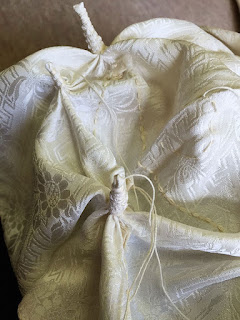Showing posts sorted by relevance for query shibori. Sort by dateShow all posts
Shibori Workshop in Kyoto
I’m going to be teaching an Indigo/Shibori workshop for Knitters At Home Expo in a few weeks, and so I’ve been thinking more about my experiences with the textiles art of Shibori. Here is a link to my class on November 7th, 10 am – 12:10 pm and 1:00 – 3:10 pm
A few years ago, while on a sabbatical to study textile, I spent three weeks in Japan. I spent a morning taking a Shibori workshop at the Kyoto Museum of Shibori. This museum has excellent exhibits about the process of Shibori, as well as many mind boggling examples in the form of kimono, wall hangings, and samples. If you are a textile artist, I highly recommend a visit here.
Shibori is a dyeing technique that is practiced around the world. It has many forms, and of course, the name changes from region to region. Basically, it is a type of resist-dyeing, where part of the fabric is either bound or clamped in order to prevent the dye from penetrating. There are many ways to achieve the ‘resist’ process. You will find resist dyeing in Indonesia, Africa, India, etc.
Japan calls this type of resist dyeing Shibori. It dates back 1300 plus years. Kyoto is a important center for Shibori, and here it is known as Kyo-Kanoko-Shibori. Thetechniques are varied, and have been passed down from generation to generation. In Kyoto, silk was the primary fabric used, and the resultant fabrics traditionally would be used by the men, women, and children of samurai. In the Edo period, high-class shibori was created on silk in Kyoto and the ordinary-class indigo shibori was created with cottons and linens in the country areas.
Our instructor was Ryo Shimada. He is Japanese, but speaks perfect English, with an Australian accent (quite amusing to me). Ryo was fantastic. He was informative, helpful and patient. I’ll discuss one technique in this blog post, and another technique is a separate blog post.
Technique One: Stitch and DyeThe first technique we covered involved stitching into the silk cloth with strong cotton thread. I believe this technique is called Kasamaki. We began by choosing a pattern we liked from the example wall. For the sake of time, all the stitching process had already been completed on our scarf, so we simply focused on the drawing-in of the threads to create the resist areas of the cloth. Here you can see a sample of the pattern I chose to do, and the threads that were already stitched with either a single strand or a double strand of cotton.
The ‘flowers’ of my design were created with single strand thread. My task was to use a stand tool to hold the knots of the ends of thread and allow me to get good tension while tightening the thread first (which outlined the flower), and then binding the projection (which would create the striations of the ‘flower petals’.
Below, you can see how the ‘protrusion’ of fabric was wrapped tightly, letting the wooden stand device aid in the process.
The second stitch technique (which I’ve seen called Nui), involved using a double-strand running stitch, and drawing the threads ‘tight’. Little pieces of cotton at each end, protected the fabric later, when it came time to pull the thread out (acting like washers). Some of these were done for me (in advance), and some I pulled and tightened myself.
Once prepped, the pieces went into the dye bath. Synthetic dyes were used, and these were heated and ready for us when we got to the de studio. After the dyeing, we spun out the excel moisture and then waited for the pieces to dry.
To remove the running stitches, one simply pulled the fabric with the palms of your hands to break the threads. To remove the threads from the ‘projections’ we snipped the end knot and undid the threads with our fingers. Then came the magic moment when two people pulled the scarf from the opposite end, and let it ‘bloom’. Wow! Too much fun!!
I’ll be posting a bit more on Shibori and Indigo. Watch for a post on clamping techniques which are much simpler to do than the stitching.
Kyoto Shibori Museum127 Shikiamicho, Nakagyo-ku, Kyoto 604-8261, Kyoto Prefecture+81 75-221-4252http://shiborijp.wix.com/kyoto-shibori-museum
An American Site with info and tools, etc.http://shibori.org/








